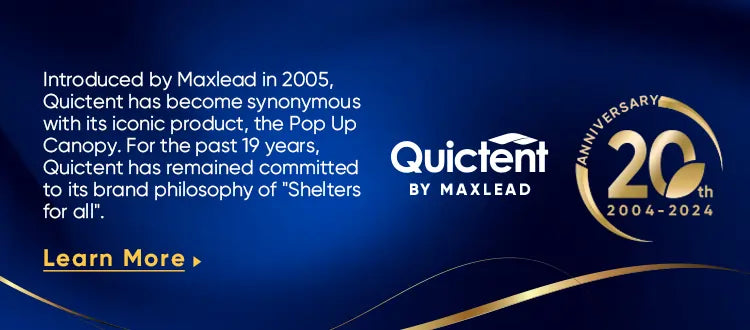Tents are essential in different outdoor activities. Whether it's a canopy tent for a backyard gathering, a party tent for an outdoor event, or a camping tent for a camping trip. In these tents, there are a variety of different tent materials. And these tent materials determine whether they can withstand the weather, daily wear, and tear. It also determines how comfortable you will be inside.
But, what are tents made of? In this guide, we'll take a closer look at the most common tent materials and their pros and cons so you can make an informed decision.

(Set up camping tents)
Canopy tent material
The canopy tent is the preferred choice for many home or business events. Such as backyard relaxation, picnics in the park, and farmers' markets. So before you make a purchase, understand the differences in these materials and choose the one you need.

(Quictent 10x20 canopy tent with sides)
Fabrics
Polyester
The most common material used for canopy tents is polyester. This is a synthetic fabric known for its durability, water resistance, and lightweight, making it a popular choice for outdoor tents.
Polyester is often treated with a PVC coating to increase its water resistance, UV resistance, and tear resistance. Besides, it is easy to clean and maintain. This is ideal for outdoor gear that may be exposed to dirt, dust, and other environmental elements.
But, it is less resistant to solubility and prone to breakage when sprayed with soot and sparks, and other substances. For safety, so try to avoid such occasions.
Oxford fabric
This is the fabric that the Quictent canopy tent uses. The grades of Oxford cloth are 210D, 420D, 600D, 900D, etc. D is the abbreviation of Denier, which is the measure of fiber thickness. The larger the number, the stronger the fabric.
Mostly polyester, polyester-cotton blended yarn, and cotton yarn interweaving, with excellent wear resistance and breathability. Washable and easy to dry and have certain water resistance. Oxford cloth used in outdoor equipment is usually coupled with PU coating, which is to provide better water resistance. It also makes the fabric stronger and resistant to tearing and abrasion.
However, Oxford cloth at the beginning of use will be stiff and easy to wrinkle.

(Canopy tent fabric comparison)
Frame material
Steel
Steel is the most common construction material and is inexpensive. It is characterized by high strength, lightweight and high stiffness.
Its disadvantages are poor fire resistance and corrosion resistance. This is why usually steel-framed tents also have a powder coating added. Powder coating is also an epoxy resin or polymer layer added to the steel frame. Protects the frame from rust and corrosion.
Aluminum
Aluminum is the second lightest of the metals, weighing only one-third as much as steel. And aluminum naturally forms a thin layer of oxide on its surface, providing excellent protection against corrosion. It also has a much longer service life.
But this means that it is more difficult to manufacture than steel, so aluminum-framed tents will be more expensive than steel frames. Since it is a softer metal, it is prone to scratches and dents.

(Canopy tent frame material comparison)
Party tent material
Party tent has many categories and sizes. Unlike canopy tents which are suitable for small events, party tents are good for various commercial events, outdoor weddings, and private parties. This is why some events have requirements for tent materials, such as the need to have CPAI-84 or NFPA 701 certification.

(Quictent 20x40 pole tent)
Fabrics
PE
It has excellent low-temperature resistance, good chemical stability, and can resist most acids and bases. So the tent with PE material is durable and not easy to break. And most of the tents made of PE material are coated so it is easy to clean. But this material is not resistant to high temperatures, once the combustion is easy to produce toxic gas.
So please do not let the party tent be made of PE material near the fire source and pay attention to safety.
PVC
It has non-flammability, high strength, resistance to weathering, and excellent geometric stability. At the same time, the material is lighter, waterproof, and moisture-proof. PVC material is thicker compared with PE, which is more suitable for year-round use. Of course, thicker fabric means less breathability.
Depending on the model, Quictent offers tent roofs and sidewalls made of 500g PVC. And it is certified fireproof, allowing you to place heaters inside the tent. It also contributes to a high level of security and makes the event go more smoothly.
Canvas
Made of cotton or linen and polyvinyl chloride, it is stable and does not fade easily after dyeing or printing. Canvas has very good density, has no air leakage, and is very resistant to wear and corrosion.
Yet, canvas fabrics are usually thicker and heavier, requiring more time and effort in transportation and installation. If the cotton canvas is not dried in time after wetting, it will easily become moldy. Because the production process of the canvas is more troublesome, the price of canvas tents is more expensive.

(Party tent fabric comparison)
Frame material
Iron
Iron is very hard, not easy to deform, and very strong and durable. But, iron frames are heavier than steel, so they are more difficult to transport. And iron is more prone to rust and requires regular maintenance to prevent corrosion. So it is better to choose steel or aluminum frame tents.
Galvanized steel
Galvanized steel is a type of steel that is protected from corrosion or rusting by coating the steel with a zinc layer. Galvanized steel has a longer life and durability than ordinary steel. It is also stronger and less prone to bending.
The process of galvanizing steel involves the use of chemicals and energy, which can have an impact on the environment. Moreover, when galvanized steel is disposed of, it may be difficult to recycle because of the galvanized coating.

(Party tent frame material comparison)
Camping tent material
A camping tent is different from a canopy tent in that it will stay outdoors for days rather than hours. So the choice of fabric for your camping tent will determine whether you can stay warm at night. Or whether it's waterproof and windproof enough.
Fabrics
Nylon
Nylon has the same excellent abrasion resistance as polyester but is much more elastic than polyester. Its thin texture, better breathability, and not easy mildew also make it one of the excellent outdoor equipment materials.
Nylon's heat and light resistance is lacking. This means that if exposed to UV light for a long time, the inside of the tent will become hotter. Nylon will also absorb water, so if you encounter heavy rain in outdoor camping, you need to put a tarp on the outside of the tent.
Polycotton
It is a kind of fabric made of a polyester and cotton mixture. It has good elasticity and strength. Better heat and light resistance, less susceptibility to mold and insects, less moisture absorption, etc. This fabric can keep the interior of the tent cool during the hot day and warm during the night.
Polycotton is heavier than polyester and nylon fabrics and is more suitable for larger-size tents for family trips.

(Camping tent fabric comparison)
Frame material
Fiberglass
Fiberglass is an inorganic non-metallic material with excellent performance, low cost, lightweight and high strength. It has good formability, and certain bendability, and is not easy to rust. It has become a common material for tent support.
The disadvantage of fiberglass is that it is easy to age, brittle, break, and heavier than aluminum frames. A fiberglass frame is more suitable for use in mild weather. If you don't camp a lot then the less expensive fiberglass frame can meet your basic needs.
Carbon fiber
It is a high-strength and high-modulus fiber. It is made of acrylic and viscose fiber as raw materials and is carbonized by high-temperature oxidation. It is very resistant to high temperatures and is lighter and stronger in weight than aluminum.
This material is more expensive, twice the price of the aluminum frame. So, unless you are very concerned about the weight and performance of the frame, aluminum would be a better choice.

(Camping tent frame material comparison)
Final Thoughts
In short, regardless of the type of tent, choosing the right material is essential to ensure perfect performance in different occasions and weather. By considering the fabric and frame material. You can choose the ideal tent to meet your needs and provide maximum comfort, safety, and durability for your outdoor activities.







